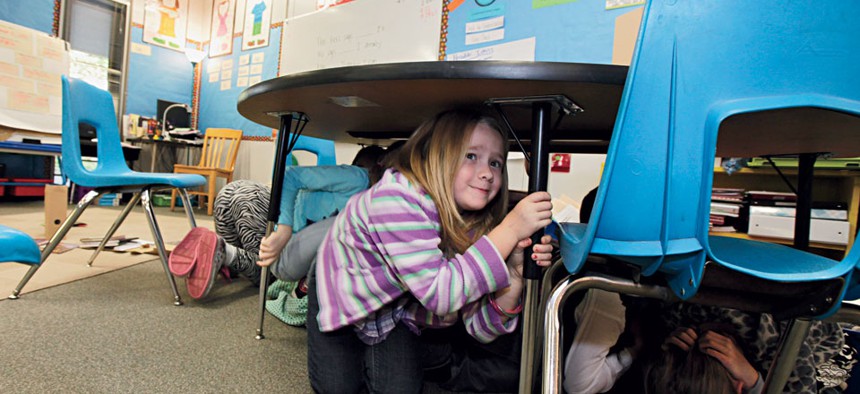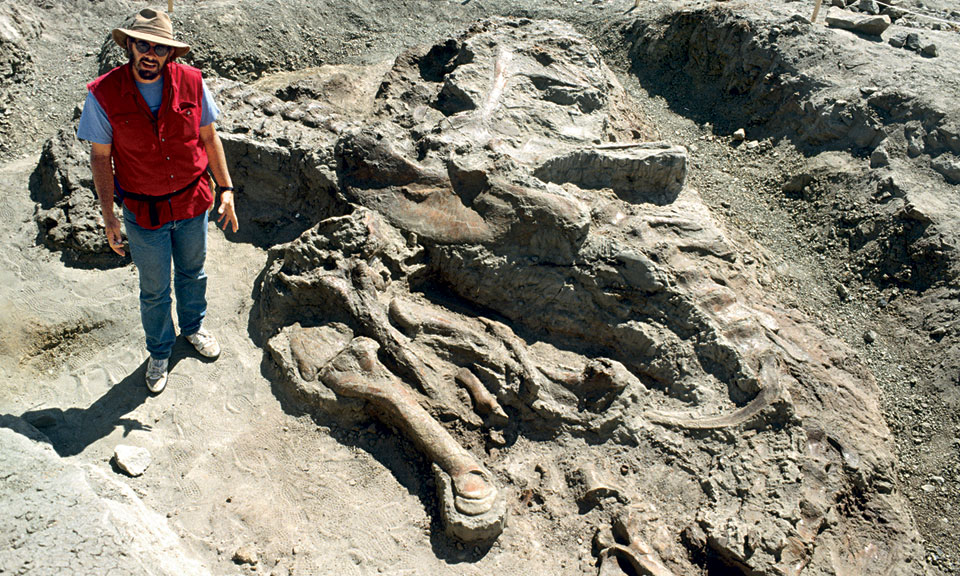
Earthquake drills prepare West Coast students like Jaely John of Washington. Ted S. Warren/AP
The Next Big Shake
Installing an earthquake warning system before it’s too late.
When a magnitude-9 earthquake struck off the coast of Japan in March 2011, it triggered an automatic warning that stopped trains, alerted students to take shelter under their desks, paused sensitive manufacturing and allowed hazardous chemicals to be isolated seconds before the quake reached them. The United States will definitely install this type of earthquake early-warning system, according to Richard Allen, director of the Berkeley Seismological Laboratory. The question is when.
“Rather than waiting until the next big quake galvanizes political action, I believe that we must build an alert system now,” Allen wrote in the journal Nature in October. Acknowledging that budgets are tight, Allen noted that the $120 million it would cost to build a West Coast system over five years is a great value when you consider that’s $2.44 apiece for the people of California, Oregon and Washington. “My morning coffee costs me $2.40,” he said.
Allen advocates developing public-private partnerships. In Japan, the government pays for the long-term operation of the geophysical networks to detect quakes and generate alerts, while the private sector delivers the alerts and provides support, Allen noted. He would also like to see partnerships within government among the U.S. Geological Survey, the National Science Foundation and the Federal Emergency Management Agency. “If these three agencies were to come together to build and deploy an earthquake warning system, that would be a huge achievement,” Allen told Government Executive .
“I am happy to give up tomorrow’s coffee in exchange for a warning before the next big shake,” he wrote in Nature .
- Rebecca Carroll
Navigating Space Junk
In the popular 3-D movie Gravity , the drama begins when a cluster of exploded satellite debris orbiting Earth at extremely high speed collides with spacewalking astronauts and their shuttle. While the movie takes some license to tell a story, the danger of space junk is real. Scientists are tracking more than half a million pieces of debris orbiting the Earth at speeds of up to 17,500 miles per hour, according to NASA. That’s “fast enough for a relatively small piece of orbital debris to damage a satellite or a spacecraft,” the space agency says.
Space junk has been orbiting Earth for as long as humans have been leaving it around.
By 1963, scientists had cataloged a total of 616 manmade objects in space, though many had already fallen back to Earth and a few had landed on the moon or veered off into orbits around the sun by that time. Alert to the potential dangers of a littered lower orbit, scientists were already calling for better cataloging and observations, and predicted 2013 levels of space junk with amazing accuracy.
- Rebecca Carroll
Open Office, Open Mind?
GSA’s vision for shared, collaborative workspace could create productivity challenges for some.
Rolling out an initiative to reduce federal real estate, the General Services Administration in September showcased its headquarters renovation, built around an open office environment. But promoting savings and collaboration through desk sharing, telecommuting and mobile devices isn’t everyone’s cup of tea.
The idea is falling flat with some Government Executive readers. “This looks good on the surface, and certainly from the bean counters’ perspective,” says one online commenter. “The message is that the employees are just interchangeable parts in the machine, that the employer can use an employee’s home as an extension of the workplace (shifting cost from the government to the employee without compensation).”
With as many as a quarter of businesses taking the open-office plunge, according to one survey, the arrangement is the hottest trend in the American workplace, says Blake Zalcberg, chief executive officer of OFM Inc., an office furniture manufacturer based in Holly Springs, N.C. “But a resounding number of customers I talk to say it’s great for some, but not for all,” he says. “The company looking at morale or for efficiency in dollars in creating space needs to strike a balance for the company as a whole.”
Many new technology firms, for example, welcome hoteling for colleagues who can “grab their laptop, move around and meet with 600 people on a whim,” Zalcberg says. But some workers are less extroverted than others, plus there’s the noise factor, he adds.
Similar warnings come from Lawrence Fitzpatrick, president of Computech, a software firm in Bethesda, Md. “The bullpen setting interrupts the deep concentration required to develop systems,” he says. “Unfortunately, the impact of decisions such as forcing types of workers who suffer lost productivity in a bullpen environment isn’t felt for one to three years, on someone else’s watch.”
- Charles S. Clark
Turns Out T. Rex Is Nonessential
A funny thing happened to Tyrannosaurus rex on the way to Washington—the government shut down. The 38-foot, 7-ton fossil has been on display at Montana State University’s Museum of the Rockies, where Jack Horner is curator of paleontology. The Army Corps of Engineers inked a deal to loan the T. rex to the Smithsonian, but furloughs pushed the move from October to April. But after 60 million years, what’s a few months?

Smithsonian/Museum of the Rockies
NEXT STORY: Furloughs Test Spirit Of Giving






